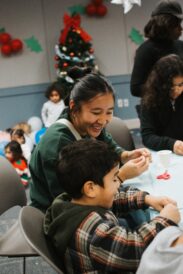BYU: Researcher revealing the hidden influence of unmarried and childless relatives
- Amy Harris with her book “Being Single in Georgian England: Families, Households, and the Unmarried,” published by Oxford University Press.
- Amy Harris, shown with her family in 1978, is the youngest of nine children.
- As a single woman with a large extended family, Amy Harris contributes to family life in many important ways. She is seen here caring for her young nephew.

Courtesy Amy Harris
Amy Harris with her book "Being Single in Georgian England: Families, Households, and the Unmarried," published by Oxford University Press.
Who studies the family history of people with no descendants?
Amy Harris does. She’s a professor of history and program coordinator for the family history major at Brigham Young University, and she studies family history and the history of family relationships — how families function and work and change over time.
“A lot of what I was reading about family was very focused on marriage and childrearing,” Harris said of her years studying 18th-century Britain in graduate school. “I thought, ‘That doesn’t even capture everything going on in my family for my married siblings — they still have sibling relationships, and they have nieces and nephews and cousins and aunts and uncles, and they become grandparents.'”
As the youngest of nine children and one of several unmarried siblings, Harris knows more happens in family life. She’s observed firsthand roles in caregiving, decision making and emotional support. This lived experience sparked questions about why unmarried individuals have been so often overlooked in both public memory and scholarly work.
Her work now expands the traditional definition of family and ancestors by focusing on those often overlooked in both genealogical records and historical narratives — the unmarried and childless. She believes family history should include all who contribute to family life, not just those who add relationships and offspring to the family tree, and that family is not defined solely by legal or biological ties but by the daily labor of care for and commitment to each other.

Courtesy Amy Harris
Amy Harris, shown with her family in 1978, is the youngest of nine children.
In her book “Being Single in Georgian England,” Harris puts a spotlight on the roles of single adults in extended family life through a detailed case study of the Sharp family, a prominent 18th-century household that includes the abolitionist Granville Sharp. The Sharp family also has a lot of people who never married or married very late or did not remarry if they were widowed young. Some had unusual fertility problems.
From their records, Harris reveals how unmarried individuals were not peripheral; they were essential to the success and stability of the extended family.
For example, she brings sibling relationships to the fore as emotionally and materially significant ties that often carried more daily weight than marital bonds. By highlighting these dynamics, Harris challenges assumptions about the kinds of relationships that are most influential in shaping the family experience.
“Families are always work because families are always under pressure,” Harris said. “Where the pressure comes from and what it looks like changes over time and is culturally specific, but there’s no soft-focus filter or roses and rainbows version of family — it just doesn’t exist.”
She’s quick to add that it doesn’t mean the work isn’t rewarding and good because relationships are meaningful only if people invest in them.

Courtesy Amy Harris
As a single woman with a large extended family, Amy Harris contributes to family life in many important ways. She is seen here caring for her young nephew.
Her work is a reminder that family life has always been more diverse and multifaced than the nuclear model suggests and that meaningful relationships exist far beyond the confines of marriage and parenthood. With a more complete perspective on families in our history, Harris feels it gives us an opportunity to rethink our present expectations for family relationships.
“I think studying the past of families helps open up some of the strictures we feel on family now,” she said. “Families did other things in the past and they made it work, they developed healthy relationships, or they did positive things, and maybe my own definitions around that can change.”
Harris also acknowledges how families are embedded in attitudes about age and gender. For example, in Georgian England, women had many legal and unspoken restrictions on them. However, family is a place where you see men and women bumping up against each other and exposing power hierarchies.
“We have ourselves attuned to seeing women as agents if they’re advocating for the vote or the abolition of slavery — something that gets in the newspaper or they protest about,” Harris said. “It’s harder to see women’s agency in domestic life because the records are thinner.”
As a tip for discovering more about women in early family histories, Harris shares how historians may first look for records and indexes that mention the men to whom women are connected for context clues. “People do some really ingenious things to get to women who aren’t necessarily on the surface,” Harris said. “Women’s history is often preserved in oral culture or family traditions, recipes and family heirlooms — you have to think differently.”
Due to her research on British families in the 1800s, Harris was appointed as a fellow of the Royal Historical Society, a prestigious honor in her field. The RHS fellowship will provide her access to additional resources, networks and historical archives, further enhancing her opportunities for research and collaboration.





